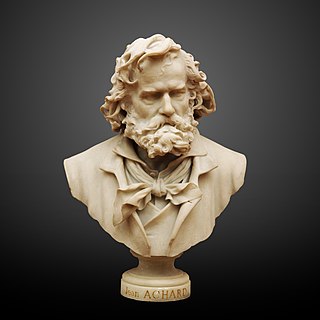
Et in Arcadia ego is a 1637–38 painting by French Baroque painter Nicolas Poussin. It depicts a pastoral scene with idealized shepherds from classical antiquity, and a woman, possibly a shepherdess, gathered around an austere tomb that includes the Latin inscription "Et in Arcadia ego", which is translated to "Even in Arcadia, there am I"; "Also in Arcadia am I"; or "I too was in Arcadia". Poussin also painted another version of the subject in 1627 under the same title.

Simon Vouet was a French painter who studied and rose to prominence in Italy before being summoned by Louis XIII to serve as Premier peintre du Roi in France. He and his studio of artists created religious and mythological paintings, portraits, frescoes, tapestries, and massive decorative schemes for the king and for wealthy patrons, including Richelieu. During this time, "Vouet was indisputably the leading artist in Paris," and was immensely influential in introducing the Italian Baroque style of painting to France. He was also, according to Pierre Rosenberg, "without doubt one of the outstanding seventeenth-century draughtsmen, equal to Annibale Carracci and Lanfranco."

Plougastel-Daoulas is a commune in the Finistère department, located in the administrative region of Brittany, northwestern France.

Pierre Max Rosenberg is a French art historian, curator, and professor. Rosenberg is the honorary president and director of the Musée du Louvre in Paris, and since 1995, he has held the 23rd seat of the Académie Française. He was Slade Professor of Fine Art at the University of Cambridge in 1987.

Les Choristes is an 1877 pastel on monotype by French artist Edgar Degas. Part of a series of similar works depicting daily public entertainment at the time, it shows a group of singers performing a scene from the opera Don Giovanni, the only work by Degas depicting an operatic performance without dancers.

The Hôtel de Toulouse, former Hôtel de La Vrillière is located at 1 rue de La Vrillière, in the 1st arrondissement of Paris. Originally, the mansion had a large garden with a formal parterre to the southwest.

Auguste-Barthélemy Glaize (1807–1893) was a French Romantic painter of history paintings and genre paintings.

Jean Alexis Achard was a French painter.
Gustave Achille Gaston Migeon was a French historian of the arts of the world.

Camille Enlart was a French archaeologist and art historian. His areas of special interest were the Middle Ages and photography.

The Incredulity of Saint Thomas is a 1543–1547 painting by Francesco Salviati. It was commissioned for the église Notre-Dame-de-Confort in Lyon by Thomas II de Gadagne, a Florentine counselor to Francis I of France. It is now held in the Louvre Museum and measures 275 cm by 234 cm. It is signed FRANCESCO SALVIATO FLO. OPUS (S.B.D.) and the apostle shown in three-quarter-profile is a self-portrait of Salviati.

Everhard or Eberhard Jabach was a French businessman, art collector, and director of the French East India Company. He was born in Cologne in the Holy Roman Empire but later naturalised as a French subject.
Nacéra Benseddik is an Algerian historian, archaeologist and epigrapher. She was born in Bordj Bou Arreridj on 4 December 1949.
Louis-Antoine Prat is a French art historian and art collector, specialized in drawings.

Claudine Marie Claire Loquen, known as Claudine Loquen [Klodin loʊkən], is a French painter in the naïve style.

The Corner of the Table is an oil-on-canvas painting by French artist Henri Fantin-Latour, created in 1872. It was exhibited at the 1872 Salon. It is held at the Musée d'Orsay, in Paris.

Apollo and Daphne or Apollo in Love with Daphne is an oil on canvas painting by Nicolas Poussin, from 1661-1664,, produced shortly before the painter's death. It is held in the Louvre, in Paris.

Caesar Restoring Cleopatra to the Throne of Egypt' is an oil on canvas painting by Pietro da Cortona, one of three works by this artist and six works by others commissioned by Louis Phélypeaux, Seigneur of La Vrillière for the gilded gallery at his new hôtel de La Vrillière in Paris - he requested that the nine works be in similar style and dimensions to Guido Reni's The Abduction of Helen (Louvre), the first painting he ever acquired. It is usually dated to 1637. It has been in the musée des Beaux-Arts de Lyon since 1811.

The Judgement of Solomon is an oil on canvas painting of the judgement of Solomon by the French artist Poussin, from 1649. Produced during his 1647-1649 stay in Rome, it is now in the Louvre, in Paris. It measures 101 by 150 cm. Art historians largely consider it as one of the artist masterpieces, in the art of the 17th century French School and French art as a whole. Several engravings were produced of the work.
















